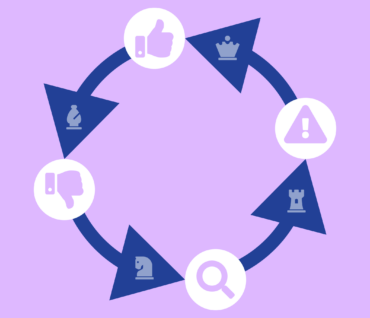
Get Started
Graphite's supplier management tool helps you onboard faster, cut time on risk reviews and streamline supplier validations. Save time and money.
July 27 2023
5 Tips to Simplify Supplier Contract Negotiations
Learn how to negotiate better contracts and save your team time by dealing with supplier contract issues before they begin.
The most influential factors to any supplier contract negotiation are in motion before a meeting ever takes place. Learn to prepare ahead of time to save your business time and money, and to save yourself a headache.
Omid Ghamami, CPSCM™, noted procurement author/speaker/consultant and CEO of the Procurement and Supply Chain Management (PSCM) Institute, has helped us put together tips for effective contract negotiation that will actually make an impact.
1. Don’t start from scratch every time.
Unless you’re working for a new company, you’d rarely find yourself negotiating a supplier contract completely dissimilar from anything ever done for your business. Typically, your business has bought from similar suppliers; in this case, history is your friend.
The idea here is not to copy what’s been done in the past. Rather, having historical contracts to work from gives you the perfect jumping-off point to ask questions. Ask: what’s been working well here? What hasn’t? What kind of problems have arisen from this supplier relationship? How are you currently measuring their success?
Once you’ve analyzed these questions, you can determine where to go next and what needs to be fixed. When you go through past deals and ask these questions, you can tease out the information you need to focus on remedies and performance results.
One pitfall you should be careful not to fall into is projecting ahead to problems you think you might face. If you’ve never faced a problem, all you can do is guess. It’s better to stay grounded in experience and fact.
2. Do your research.
An important principle of procurement negotiation is to do your research. Think of yourself as an investigator. What can you dig into about your supplier? What do they value? What do they avoid?
Do your due diligence in researching everything you can about their business. Read their annual reports and dive into the details. Try to learn which of their products or areas of business are doing really well and which are struggling.
If you can figure out what’s keeping them awake at night, you can come back to them with a proposal that helps them solve the problems you’ve discovered that they’re facing. Often they’ll be pleased to provide a much larger discount in return. Instead of thinking about how your business can get what you need– come in with value creation in mind. How can you be of benefit to each other?
After that comes the negotiations. Think of the negotiations as transferring value between the two parties. The idea is not how much of the pie you can get but how many more pies you can bake together.
3. Surgically cut costs.
It can’t be stressed enough– the biggest savings don’t happen because of at-the-table price squabbling. Any savings at the table are simply an exercise in supplier profit compression or saying, “Give me a better price.” But all that will do is give suppliers a bad taste.
It’s important to cut costs surgically, but that needs to be figured out before you sit at the table. Sit down and cut everything you can until there’s nothing left to cut. Generally, around 18% of money sitting in product and service design doesn’t need to be there to meet the performance metrics identified by the end user.
Then, with those reductions identified, it can become a question of collaboration with your supplier. You’ll find you have a more eager supplier when you can shift from negotiation to collaboration.
4. Custom isn’t always better.
It can be easy to fall into the trap of becoming too custom. Instead, think: how can we make this as simple as possible?
When a supplier has to put together a lot of custom considerations, they can charge more, but it’s still very likely not their preference. The supplier has been in their industry the longest. They’ve come across issues and learned to solve them. If you come in and decide you know better (which you likely don’t), that can cause issues.
Go in expecting that the standard will fit your needs and only vary where you absolutely have to. You’ll find this saves you a lot of time, money, and headaches.
5. Find your bargaining power.
When you have researched and learned about your supplier’s business, you can drill in and find areas where you can increase your bargaining power. For example, say a supplier has on- and off-seasons, and they make more money during their on-seasons and spend more money during their off-seasons. If you have flexibility, you can offer to pay them during their off-season. It’s a great bargaining point for you and a great opportunity for them.
If the offer was enticing enough, you could ask for sway in other high points on your priority list. Without investigating that supplier’s needs, you might get considerations you’d never have achieved.
In negotiations, it’s a big fallacy to assume that money is the only important thing to the other party. You never want to enter a negotiation assuming that is the case. There are always other considerations that weigh into the value of a contract for both parties.
Key Takeaways
The most important part of supplier contract negotiation isn’t anything you’ve read in a negotiation book. It has nothing to do with at-the-table tactics but rather with preparation and knowledge of both parties’ needs.
When you come to the table prepared, you’ll find greater success in creating contracts that benefit everyone– but you’ll also see greater success down the line when the contract has been put into practice.
It’s your job to do your research and come ready to craft a contract that will drive success for your business far into the future.
What next?
If you’re looking for a solution to help you centralize and manage your supplier contract, keep tabs on when they’re renewing, and what steps need to be taken, then look no further.
Graphite Connect allows procurement teams to implement streamlined contract organization and alerts when contracts are coming up for renewal. Graphite can also help you simplify supplier intake, onboard new suppliers, and even keep track of key success metrics.
Interested in Learning More?
Meet with a member of our team to learn how to accelerate your supplier onboarding.
Request a Demo




